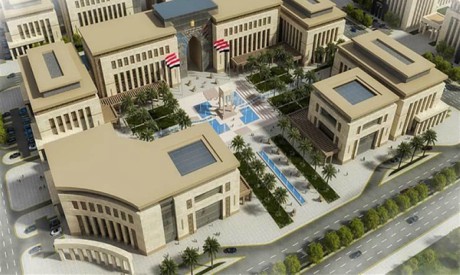
The ministerial district in Egypt's New Administrative Capital
What will happen to the Downtown buildings that currently house government ministries when the latter move to Egypt’s New Administrative Capital? That is the question that the Cairo Heritage Development Committee (CHDC) met earlier this week to discuss.
The meeting tackled the development scheme for the ministerial precinct in Downtown Cairo and proposals to rehabilitate historic palaces in Cairo and other governorates in Egypt. The transfer of state employees to the New Administrative Capital will take place in 2020.
Headed by former prime minister Sherif Ismail, the committee reviewed a report from a technical sub-committee providing detailed information about the area, its relationship with neighbouring areas, traffic, and green spaces and parking areas, Tarek Atia, spokesperson for the CHDC, said.
The CHDC was formed in 2016 with a mandate to examine strategies for the future of Downtown and Historic Cairo.
The report identifies the ministerial precinct as an area occupied by ministerial and administrative buildings whose employees will be transferred to the New Administrative Capital.
It houses monuments on Egypt’s Heritage List, structures built in a distinguished architectural style, and governmental buildings not on the Heritage List.
It also divides the zone into several domains according to geographical location. It suggests allocating the square adjacent to the old American University in Cairo campus in Tahrir Square for entrepreneurship, especially in the field of technology and the creative industries because this zone could be very attractive to investors.
The technical sub-committee also suggested the establishment of more green spaces not only to improve the quality of life for inhabitants and visitors, but also to increase the asset value of the precinct.
Proposals for traffic modifications and the creation of multi-storey garages and pedestrian passageways to be connected to other historic areas were also introduced.
The CHDC decided to commission a detailed study of the area’s traffic and development options, with this later forming the cornerstone of the rehabilitation plan for the ministerial precinct, Atia said. The committee will then determine the best use for separate buildings in the zone, along with financial plans to study different opportunities, he added.
Examples of successful renovation projects in Downtown Cairo have included the renovation of the Viennoise Hotel, an eco-friendly historic property. The building was built in the 1890s, a decade which witnessed a construction boom in Cairo.
Last May, the committee proposed a law regulating commercial activities and the ownership of historic buildings in the area, part of Khedival Cairo. Part of the CHDC’s mandate is to draw up a comprehensive master plan balancing the area’s historic preservation with its economic growth potential.
As part of its longer-term plans, the committee has established a series of specialised sub-committees to study issues such as the urban planning and financing of the larger Downtown project.
The Downtown district is well known for its unique architectural style and its buildings dating back in some cases to the late 19th century.
While many of these buildings have fallen on hard times, there is widespread acknowledgement that a concerted focus is needed to restore the city’s historic core to its former glory as an admired and vibrant world capital.
The CHDC is thus working with both public and private-sector stakeholders on helping this historic district realise its true potential.
* A version of this article appears in print in the 31 January, 2019 edition of Al-Ahram Weekly under the headline: Moving ministries
Short link: